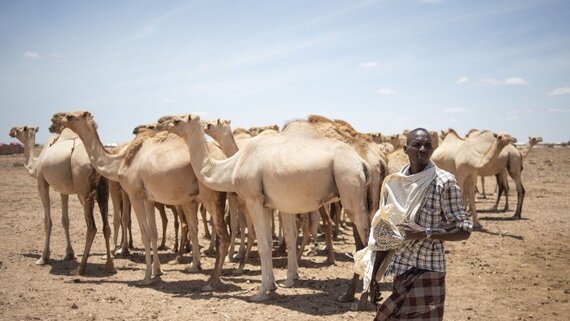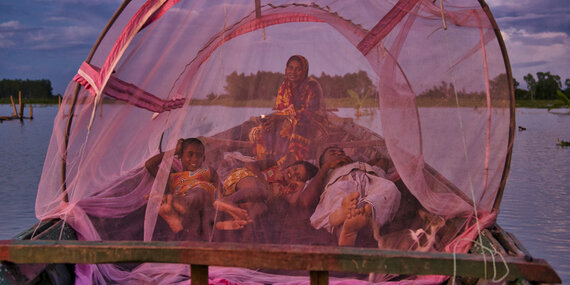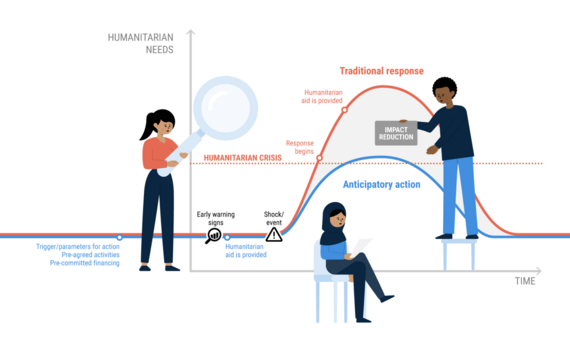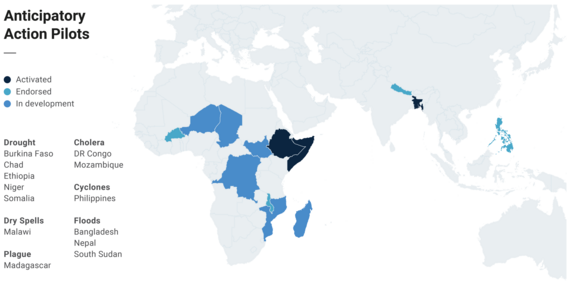Satkhira, Bangladesh
A family rests under a mosquito net on the boat where they slept after their house was submerged. In early 2020, this family lost the only land they owned to river erosion. This phenomenon is made worse by climate change and more intense monsoons. They had taken a three-year lease for new land in their village. But later that year, the house they had just built was submerged in a second round of flooding that impacted thousands of people living in low-lying areas. They were among those who received a cash payment from WFP, which allowed them to buy food and stay safe as they waited out the flooding. Cash transfers empower families to prepare for looming hard times by purchasing essential supplies, such as food and medicine, strengthening their shelters, protecting their assets and moving to safer areas. WFP/Sayed Asif Mahmud
An estimated half of all today’s crises are somewhat predictable and 20 per cent are highly predictable. However, less than 1 per cent of the financing for these crises is pre-arranged. As the gap grows between humanitarian needs and the resources required to meet them, anticipatory action offers a way to make these resources more efficient.
Anticipatory action is a set of humanitarian interventions triggered once a pre-agreed forecast threshold is crossed. Supported by pre-agreed finance, anticipatory action prevents or mitigates potential disaster impacts before a shock, or before acute impacts are felt. Acting early mitigates the shock impact and reduces humanitarian needs, helping to protect hard-won development gains and enhance resilience.
A High-Level Event on Anticipatory Action took place in September 2021, attended by officials from 75 UN Member States and leaders from 60 international CSOs. A clear political will was expressed to act ahead of predictable crises in addition to an explicit recognition of the transformative potential of this approach.
In 2020, the ERC committed to invest up to $140 million from CERF over a two-year period in a set of anticipatory action pilots that demonstrate how collective and coordinated anticipatory action could work at scale. The pilots will also evaluate to what extent anticipatory action is faster, cheaper and more dignified than the traditional response. Pilot countries include Bangladesh (monsoon floods), Burkina Faso (drought), Chad (drought), DRC (cholera), Ethiopia (drought), Madagascar (plague), Malawi (dry spells), Mozambique (cholera), Nepal (floods), Niger (drought), the Philippines (cyclones), Somalia (drought) and South Sudan (floods).
Rigourous learning from the pilots so far has revealed that anticipatory action is:
Fast. In Bangladesh, finance was approved within four hours — the fastest-ever CERF allocation — enabling agencies to distribute aid one to five days before a rapid-onset flood struck the most vulnerable people.
Cost-effective. In Bangladesh, agencies were able to procure ahead of peak needs. This meant that prices were lower and the transport of relief items was cheaper. UNFPA saved 12 per cent and FAO increased its reach by more than 10 per cent due to lower unit costs. In Somalia, the initial anticipatory funding of $15 million helped mobilize an additional $181 million. Collectively, these funds helped prevent 500,000 people from sliding into IPC Phase 4 between July 2020 and January 2021.
Impactful. In Somalia, WHO found that outbreaks of key epidemic-prone diseases, especially acute watery diarrhoea, malaria, severe acute respiratory infections and bloody diarrhoea, were reduced in the target districts, compared to a similar time in the previous two years. IOM found that the anticipatory rehabilitation and upgrading of boreholes has improved household finances, increased mental health, kept livestock healthier, reduced water-related disputes and mitigated drought-related migration.

Doolow, Somalia
Since late 2020, delayed and erratic rainfall has affected many parts of Somalia. This caused devastating water shortages, with widely depleted water reservoirs, and loss of pasture and livestock, and led the Government of Somalia and the United Nations to declare drought in April 2021. To mitigate the worst humanitarian impacts of the drought, UN agencies and partners are implementing anticipatory action with a CERF allocation of $20 million. Activities focus on mitigating loss of livelihoods and declines in food consumption, ensuring continued access to water, preventing school dropouts, detecting and controlling disease outbreaks, and mitigating protection risks.
IOM/Tobin JonesDignified. Beneficiaries who received support before peak flooding in Bangladesh were able to prepare themselves and face the crisis on their own terms. Spillover effects are also evident: some 76 per cent of women and girls who received hygiene kits were more likely to access regular health care, continue school, generate income, or participate in social and community activities compared to non-recipients.
Improving the quality of programming and localization. Advanced planning leads to better collaboration between UN agencies and their implementing partners during the programme design phase. In Bangladesh, UNFPA designed dignity kits specifically for the transgender community, because it knew the profiles of target beneficiaries in advance. Bangladesh-based agencies also now look at joint targeting at the household level instead of area-based coordination of programming only.
Encouraging accountability. The rigorous approach to learning and documentation that OCHA and partners apply to anticipatory action sets future standards in increasing AAP. Pilots in Bangladesh, Ethiopia and Somalia show that if learning is planned and integrated from the outset, better accountability and programming can be achieved.
Further reading
Source: OCHA
Source: OCHA







